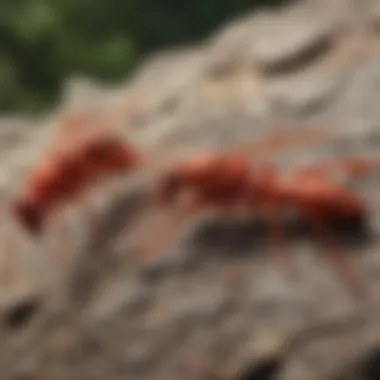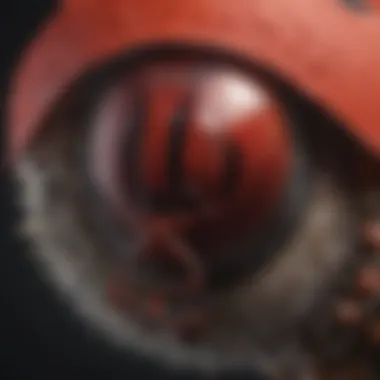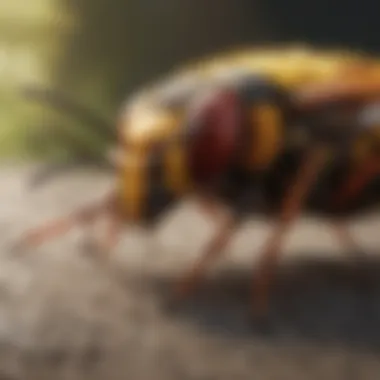Red Wasp Removal: Strategies and Considerations


Intro
Red wasps, often considered a nuisance, can pose significant threats to both outdoor activities and structural integrity of homes. Their aggressive nature coupled with painful stings can lead to emergency situations, particularly for those with allergic reactions. Understanding how to manage these pests effectively is crucial for homeowners and anyone who spends time in their gardens. In this article, we will explore essential strategies for identifying these wasps, examine their behavior, and discuss various removal techniques.
The aim is to equip readers with knowledge and practical tips that foster a wasp-free environment while maintaining safety and respecting ecological balance.
Understanding Red Wasps
Understanding red wasps is crucial for homeowners and gardeners who wish to manage their presence effectively. These insects are not merely nuisances; they play specific roles in the ecosystem. Gaining insight into their biology, behavior, and environmental impact can significantly aid in determining the best removal strategies. Moreover, developing a comprehensive understanding of red wasps can help reduce the risks associated with their presence, both for human health and property.
Biology and Identification
Red wasps are distinguished by their striking coloration. Typically, they have a reddish-brown body with black markings, but this can vary among species. The most common red wasp species in the United States is the Polistes carolina. They build nests that are generally paper-like and can be found in various locations, including under eaves or in tree branches. Identifying these insects accurately is critical to ensure that appropriate removal measures are utilized. Their size ranges from 0.5 to 1 inch, and they possess long, slender bodies with elongated legs that make them quite agile in flight.
Knowing the differences between red wasps and other stinging insects is also essential. Unlike some bees, red wasps do not have furry bodies. Instead, their smooth exoskeletons help in identification. Casual observation of their nests can assist in identification too, as their nest structure is usually open and unfurnished. Recognizing these signs is vital for effective pest management.
Social Structure and Behavior
Red wasps exhibit fascinating social behaviors. They operate in colonies that can contain dozens to hundreds of individuals. Each colony is typically led by a single queen, with workers taking on the constructed responsibilities such as gathering food and expanding the nest. Understanding their social hierarchy is important for those considering removal strategies, as disrupting a colony can provoke aggressive defensive behavior.
Moreover, red wasps are predatory; they often hunt other insects, which makes them important for controlling pest populations. However, this behavior can lead to conflicts with humans, especially when nests are built too close to residences. Recognizing their behavioral patterns, such as nesting cold season activity or foraging habits, can help in anticipating and managing encounters, thus reducing potential threats to personal safety.
Environmental Impact
Red wasps serve valuable functions in many ecosystems. Their role as predators significantly contributes to controlling various pest species. This natural pest management can benefit gardens and farms, potentially reducing the need for chemical pesticides.
However, while their environmental contributions are notable, the presence of red wasps can also lead to conflict with human activities, especially where their nests are located near places of high human traffic. It is worth considering that removing wasp nests comes with ecological trade-offs. Disturbing a red wasp colony may lead to increased pest populations if their natural predatory role is eliminated. Hence, strategies for removal must consider both immediate concerns and long-term ecological impacts.
"Understanding the role red wasps play is as important as effectively managing them; smart strategies can benefit both humans and ecosystems alike."
With a thorough understanding of these aspects, homeowners can make informed decisions about appropriate actions to take regarding red wasp management.
Why Red Wasp Removal Is Necessary
Removing red wasps is crucial for various reasons that directly affect individuals and their environments. Ignoring their presence can lead to serious health risks, property damage, and negative impacts on local ecosystems. Understanding these factors can be important for anyone dealing with or contemplating the management of red wasps.
Health Hazards
Red wasps, known for their aggressive nature, pose significant health hazards. A sting from a red wasp can be extremely painful and, for some individuals, may result in severe allergic reactions. This is particularly concerning for those who have a known sensitivity to stings. In extreme cases, a sting can lead to anaphylactic shock, a life-threatening condition that requires immediate medical attention. Furthermore, children and pets are particularly vulnerable to wasp stings due to their unpredictable behavior. Thus, ensuring the removal of these pests is essential to protect the health and safety of all household members.
Property Damage
The presence of red wasps can lead to considerable property damage. They are known for building nests in various locations around and inside homes. These nests can be large and grow over time, causing potential structural issues. For example, if a nest is built in an attic or within walls, it may lead to insulation damage or even create entry points for moisture and mold. Homeowners may also face issues if nests are located in areas such as eaves or doorways, leading to damage from the wasps' aggressive behaviors when disturbed. Thus, prompt removal is critical to avoid both immediate danger and long-term property issues.
Impact on Ecosystems


While red wasps do play a role in local ecosystems as predators of other pests, their presence can still have negative consequences. Large populations can disrupt the balance of local insect populations, leading to potential overpopulation of other pests. This imbalance may affect various plants and animals in the vicinity. Therefore, while managing red wasps, it is important to consider not only their removal but also the methods used, ensuring that ecological health is maintained.
Effective management of red wasps reflects a responsible approach to pest control, balancing safety, property protection, and ecological considerations.
Identification of Red Wasp Nests
Identifying red wasp nests is crucial for effective management and removal. Understanding where these nests are located helps homeowners take measures before an infestation escalates. Early detection allows for proactive strategies that minimize risks associated with wasp presence, such as stings and property damage. Recognizing red wasp nests contributes to overall pest management and enhances safety around homes and gardens.
Common Nest Locations
Red wasps often build nests in places that provide shelter and protection. Here are the most common locations where you may find these nests:
- Under eaves: Red wasps frequently attach nests to the underside of eaves on roofs or porches, utilizing the overhang for protection from the elements.
- Trees and shrubs: These wasps prefer the shelter offered by trees, especially near dense foliage that can conceal their nests.
- Attics and garages: Inundated with dark and undisturbed areas, attics and garages are often attractive nesting sites for red wasps seeking safety.
- Fences and buildings: They may construct nests on wooden fences, sheds, or any structural element that offers a vertical surface.
- Outdoor furniture: Cushions, grills, and other outdoor items that remain stationary can host wasp nests as they search for inconspicuous locations.
Recognizing these common areas can assist homeowners. Regular checks in these spots can lead to early intervention.
Signs of Infestation
Detecting signs of infestation is essential. Several indicators may suggest the presence of red wasp nests:
- Increased wasp activity: Frequent sightings of red wasps around your property, especially near potential nesting sites, indicate that their home might be nearby.
- Nest appearance: Observing a paper-like nest structure can confirm the presence of wasps. Nests can be irregular in shape and vary in size, usually around the size of a basketball or larger.
- Wasp behavior: If wasps are seen aggressively defending a specific area or property, it often points to a nearby nest.
Identifying the signs of infestation can help in initiating prompt removal measures to protect your home and family.
Having keen awareness of these signs allows homeowners to address the problem early. Prevention starts with recognizing the behavior and habits of red wasps.
Methods of Red Wasp Removal
Effective removal of red wasps requires a clear understanding of both the methods available and the implications of each choice. Awareness of the strategies can help mitigate health risks and avoid damages to property, making this a crucial topic for homeowners and gardeners. Assessing your specific situation will guide you in selecting the most appropriate method—whether it involves the assistance of pest control services or a more hands-on DIY approach.
Professional Pest Control Services
Engaging professional pest control services is often an optimal choice for removing red wasps. These experts bring specialized knowledge and experience that can significantly enhance the efficiency of the removal process. They typically employ a comprehensive inspection to determine the extent of the infestation and the precise location of nests. This thorough approach ensures that all active nests are identified, which is crucial because red wasps can be aggressive when their nests are disturbed.
Using professionals can also reduce the risk associated with removal for non-trained individuals. Experts will utilize equipment and techniques designed for safety and effectiveness. They often have access to advanced chemical treatments and pest management systems, making the removal process more streamlined. Furthermore, licensed professionals are usually compliant with local regulations, ensuring that the removal method used is legally acceptable.
"Professional pest control services can save time and reduce personal risk, making them a smart choice for many homeowners."
DIY Removal Techniques
For those who prefer a more hands-on approach, DIY removal techniques can be effective, but they come with significant risks. Obtaining knowledge about safe practices is essential before attempting to remove red wasps yourself. Essential tools include a protective suit, a wasp spray, and a ladder if the nest is above ground. Before starting, it is important to approach the nest either early in the morning or late in the evening when wasps are less active.
Some common DIY techniques include:
- Spraying the nest directly with insecticidal spray designed for wasps.
- Pouring boiling water into the nest at night.
- Using soap and water solutions that can suffocate the wasps.


While DIY methods can be cost-effective, evaluaton of the threat to personal safety is crucial. Incorrect techniques can provoke the wasps, leading to painful stings. For extensive infestations, or if there are uncertainties about the methods, hiring a professional might be more advisable.
Chemical versus Non-Chemical Methods
Choosing between chemical and non-chemical methods entails examining effectiveness versus safety. Chemical methods typically include insecticides specially formulated for wasps. These products can kill wasps on contact and often contain specific ingredients designed to penetrate and destroy nests. However, their usage raises concerns related to toxicity and environmental impact.
On the other hand, non-chemical methods focus on prevention and removal without toxic substances. These may include:
- Habitat alteration to discourage nesting.
- Use of traps that capture wasps without chemical ingredients.
- Natural repellents such as peppermint oil or essential oils.
Homeowners should weigh their priorities when deciding. If safety and environmentally friendly practices are paramount, non-chemical methods might appeal more. Conversely, for swift results, one might lean toward chemical solutions. Understanding your specific context and risk tolerance is key to making an informed decision.
Safety Measures for Removal
Ensuring safety during the removal of red wasps is essential. The process can pose risks, not just from physical harm but also from psychological stress. Knowing how to protect oneself can lead to a smooth removal experience. Prioritizing safety means reducing the chances of stings and potential allergic reactions, which can be severe for some individuals. Moreover, safety protocols help in maintaining a controlled environment. This section focuses on two major components of safety: Personal Protective Equipment and Emergency Response Procedures.
Personal Protective Equipment
Choosing the right Personal Protective Equipment (PPE) is fundamental when dealing with red wasps. This equipment serves as a barrier against potential stings and injuries. Here are key items to consider:
- Protective Clothing: Wear long sleeves and pants made of thick material. This prevents wasps from stinging through clothing. Light colors are advisable as bright colors can attract wasps.
- Gloves: Durable gloves can shield your hands from stings while you are working on removing nests.
- Face Protection: A veil or safety goggles can ensure your face and eyes are shielded. Wasps may target these areas when feeling threatened.
- Sturdy Footwear: Closed shoes like boots can protect the feet. Avoid open-toed shoes even if working close to the ground.
- Dust Masks: In case of chemical use or working in dusty areas, a dust mask can help you avoid inhalation of harmful substances.
Using PPE not only provides physical protection but also gives a sense of security. The psychological comfort of being equipped can enhance focus during removal.
Emergency Response Procedures
Having a plan for emergency scenarios is vital. This ensures a quick response if someone is stung or experiences a severe allergic reaction. Here are essential steps to follow:
- Know Allergies: Ensure all individuals present are aware of any allergies to insect stings. If someone is known to have a severe reaction, having their medication close by is critical.
- Control Panic: In case of a sting, staying calm can make a crucial difference. Panic can escalate the situation, making the removal more hazardous.
- Seek Immediate Help: If someone is stung and exhibits severe symptoms like difficulty breathing or swelling, call emergency services right away.
- Have an EpiPen Ready: Individuals with known allergies should carry an EpiPen. Utilizing it immediately can save a life during an allergic reaction.
Always have a first-aid kit on hand during wasp removal. This includes antihistamines, ice packs, and bandages.
- Identify the Location: If possible, note where the wasp nest is located for responders. This can aid in effective treatment.
Following well-defined emergency procedures greatly enhances operational safety. With the right awareness and preparation, risks associated with red wasp removal can be considerably minimized.
Preventative Strategies to Avoid Future Infestations
Preventative strategies are essential for minimizing future red wasp infestations. Addressing this issue proactively is more effective than relying on reactive measures after infestations occur. By implementing these strategies, homeowners can create an environment less attractive to these pests. The focus is to reduce suitable habitats and food sources that may attract wasps. Additionally, understanding these strategies can save time and resources by lessening the need for extensive removal efforts later on.
Habitat Modification
One of the most effective methods for preventing red wasp infestations is habitat modification. This involves altering the environment around your home to make it less inviting to wasps. Here are some key steps to consider:
- Remove Food Sources: Keep outdoor eating areas clean. Clean up food spills and cover garbage cans. Food scraps can attract wasps.
- Seal Entry Points: Examine the exterior of your home for cracks and crevices. Seal potential entry points to prevent wasps from building nests inside or accessing sheltered areas.
- Manage Vegetation: Keep bushes and trees trimmed. Overhanging branches may provide suitable nesting sites. Remove unnecessary foliage to maintain a less appealing habitat.
- Limit Standing Water: Ensure there are no areas of standing water near your home. Wasps need water, and standing water can attract them.


Implementing these modifications can significantly decrease the likelihood of attracting red wasps. Not only does it improve safety, but it also enhances the overall environment of your outdoor space.
Regular Inspections
Regular inspections are another crucial element in preventing red wasp infestations. Monitoring your property consistently can help identify and address potential issues before they escalate. Here is how to conduct effective inspections:
- Check Common Nesting Areas: Look for nests in sheltered areas such as under eaves, in garages, and behind shutters. Early detection of nests allows for timely action.
- Observe Activity Levels: Pay attention to wasp activity during the warmer months. An increase can be indicative of a nest nearby. This can help in pinpointing where nests may be located.
- Inspect Garden Areas: Regularly check your gardens and outdoor spaces for nests or any signs of wasp activity. Keeping those areas clean can discourage nesting.
- Document Findings: Keep a record of your inspections and findings. This can be helpful for recognizing patterns in wasp activity and formulating responses.
Being proactive with regular inspections can help maintain your home as a wasp-free environment. It ensures that if they do decide to move in, action can be taken quickly to remove them before they establish a more permanent presence.
Preventative strategies emphasize proactive, long-term solutions to minimize disruption from red wasps.
By focusing on these habits, homeowners can contribute significantly to reducing future encounters with red wasps, making their living space more pleasant and safe.
Legal and Ethical Considerations
Understanding the legal and ethical dimensions of red wasp removal is crucial for homeowners and pest management professionals alike. Many people may overlook these aspects while focusing primarily on the practical removal techniques. However, navigating the legal framework and adhering to ethical standards can significantly impact the effectiveness and morality of pest control practices. Compliance with local laws ensures that removal efforts do not inadvertently lead to legal repercussions. It also fosters responsible practices that respect local wildlife and ecosystems.
Local Laws and Regulations
Various regions have established laws and regulations governing the control and removal of pests, including red wasps. These legal provisions can vary widely, often depending on local wildlife protections and agricultural standards. Understanding these local laws can help avoid fines or even legal action. For example:
- Permits: Some areas may require permits for certain types of pest removal, especially when dealing with species that have conservation status.
- Chemical Use: Regulations often dictate which chemicals can be employed for wasp control. Unauthorized use of harmful pesticides can lead to significant penalties.
- Reporting Requirements: In certain jurisdictions, pest control activities—especially those involving nests in public areas—must be reported to local authorities.
It is advisable to consult local guidelines or resources such as state agricultural departments to ensure compliance. By familiarizing oneself with the legal framework, individuals not only protect themselves legally but also contribute to a larger respect for public health and safety.
Ethics of Pest Control
Ethical considerations in pest control emphasize the importance of humane treatment of all living creatures, including red wasps. Approaching pest removal with an ethical mindset can influence methods chosen and outcomes achieved. Here are some essential ethical principles:
- Non-lethal Methods: Whenever possible, home and property owners should consider non-lethal removal strategies. For example, relocating nests safely rather than exterminating the wasps may help maintain ecological balance.
- Awareness of Biosecurity: Ethical pest control involves being aware of how removal efforts can affect surrounding wildlife. Disturbing a wasp population can lead to unintended negative consequences for local ecosystems.
- Community Responsibility: Homeowners should also consider the impact of their decisions on neighbors. In situations where a nest poses a risk, collaborating with community members can ensure mutual safety without resorting to drastic measures.
Taking an ethical approach allows for a balanced relationship with nature. It places importance on humane treatment and seeks to educate others about the benefits of respecting all species. This awareness is essential for reducing fear-driven reactions towards pests and fostering a more enlightened understanding of natural ecosystems.
"Engaging in ethical pest control not only protects your immediate environment but also contributes to the overall health of the ecosystem."
By integrating legal compliance with ethical considerations, homeowners and pest management professionals can create a framework for responsible red wasp removal. This conscious approach can help maintain both a safe living environment and the integrity of local ecosystems.
The End
Red wasp removal is not just about eliminating a nuisance; it is critical for maintaining safety and preserving environmental integrity. Understanding the importance of effective strategies for removal can greatly benefit households, especially where children or pets are present. The consequences of neglecting red wasp infestations can lead to serious health risks and property damages, as these wasps are known to be aggressive when provoked.
The Importance of Awareness
Awareness of red wasp behavior and nesting habits is vital for effective pest management. Homeowners should educate themselves about the signs of infestation and the potential hazards associated with these pests. By being aware, individuals can take proactive measures, including regular inspections of their property. This vigilance may lead to early detection, which can significantly reduce the risk of severe allergic reactions to stings.
"By recognizing the early signs of red wasp activity, homeowners can respond swiftly, minimizing risk to their families and homes."
Continuing Education on Pest Management
Continuing education on pest management practices is essential. Homeowners should keep up with the latest research and strategies related to pest control, specifically for red wasps. Helpful resources can be found through local cooperative extensions or online platforms such as Wikipedia and Britannica. Attending workshops or training sessions can enhance understanding of safe removal techniques and the ecological role these wasps play. It’s important to balance personal safety with ethical considerations in pest management. Such education fosters not only a safer living environment but also encourages responsible stewardship of the ecosystem.







